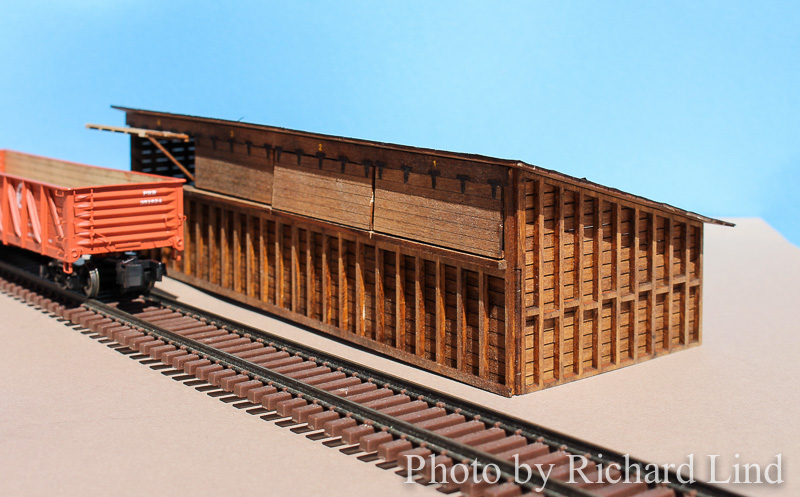
By Richard Lind
Today, when we see coal moving by rail it’s usually in 100-ton hoppers or 100-ton gondolas with rotary couplers. But in the transition era, coal moved in 50 or 70-ton hoppers and 50-ton 40-foot gondolas. In fact, about 30 percent of coal mine production in the Midwest moved in gondolas. So why were they using gondolas? The answer lies with the coal merchants who ordered a carload of coal and didn’t have enough business to justify the expense of building facilities that could accommodate hoppers. They often had a simple shed and the gondolas were shoveled out by hand.
Now you can get a laser-cut kit for one of these sheds in HO. Hidden River Model’s HRM-38 Coal Facility has a footprint of three inches by seven and a half inches. The HRM kit comes in a 4 mil clear plastic bag. It includes black paper cut in strips for roll roofing and hinges that are also cut from black paper. The shed has plank walls and when you hold them up to the light, you see daylight between them all. The underside of the roof sheets are scribed to represent roof boards and they are also scribed to show thelocation of each rafter and partition frame. None of the sheets are self-adhesive and there are no corner tabs, nor should there be. Parts are identified on the carrier sheet and door braces and hinges are spaced for you so you can glue them on as a unit. There are three pages of instructions. A general instruction sheet that applies to all HRM kits, a sheet with an isometric exploded view of the kit’s construction, and a sheet of instructions written specifically for this kit.
I built this kit in S scale and it went together without any problems, following HRM’s instructions. I have a few tips.
- When the laser-cut sheets are stained, the wood grain looks entirely out of scale. Fortunately, this effect is broken up and disappears as you assemble the kit.
- When cutting out the parts for assembly, hold the carrier sheet up to the light so you can see where you have to cut. HRM keeps the places to cut to a minimum, usually occurring on the ends of long parts and the middle of small parts.
- The parts with the planks for the end walls and partition walls are fragile. I broke three of the five in half by picking them up from the top and bottom edges. This was not a bad thing, because it allowed me to glue them onto the frames half at a time. So, I intentionally broke the other two. After you glue the boards onto a frame, flip the frame over and look for any glue that may have squeezed out. Clean it off by scraping with a hobby knife with a chisel blade.
- The kit is assembled upside down and I used a square to make sure the partitions were at a right angle to the roof. The rafters extend beyond the partitions and ends on the track side. Make sure the ends of the rafters align with the the partitions and ends of the shed on the side away from the track (the lower edge of the roof). To help line up these parts I used a steel rule with cork on the bottom and a weight on top.
- When gluing the front wall assembly to the partitions and ends, everything was still upside down. Five Irwin quick-Grip 4-inch clamps that I got from the hardware store helped.
- I added the braces to the backs of the doors and trimmed the spacers away from the braces. Then I sanded the braces flush with the edges of the doors where needed. To get my hinges positioned right, it was easier to attach just one strap of a hinge to the door and then glue the remaining hinge straps on one at a time so they would be aligned. When dry, the paper spacer is trimmed away from the hinge butts.
- The hinge butts kept the doors from falling into the bins while they were glued to the top trim piece. Here, I could apply glue to all five hinge butts at once when gluing the doors in place. When the shed was finished, the door sills were close to the tops of my gondolas and the openings to the bins at the rear of the structure were a scale eight feet high.
- Finally, I numbered the bins using Model Graphics (Woodland Scenics) dry transfers so the switching crew would know where to spot a gondola load of coal.
Now I have a common line-side industry and a destination for my forty-foot gons.
[Richard Lind is a former SMD member and Wheel Report editor now living in New Mexico. -Ed.]
